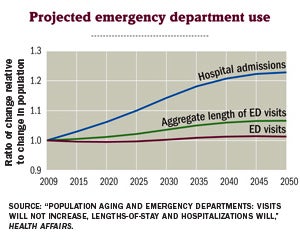Aging population will impact ED capacity, admissions

When it comes to emergency care and admissions, bigger may not only be better for hospitals, it also may be essential as Americans
grow older.
While an aging population will not increase the number of emergency department (ED) visits, it will cause lengthened visits that require a 10 percent increase in ED capacity between now and 2050. Hospitalizations from EDs are expected to increase by 23 percent during the same period.
The findings were reported in a recent study led by Daniel J. Pallin, M.D., research director for the department of emergency medicine, Brigham and Women's Hospital in Boston.
"Nobody is surprised that we have to build more hospitals and more emergency departments when the population of the United States is growing," Pallin says. "We're finding that we need the EDs to grow faster than population growth."
According to the study's analysis, the number of ED visits is expected to stay on pace with the U.S. Census Bureau's projected growth in population from 307 million today to 439 million in 2050.
The research team discovered that time spent in EDs will increase to a total of 515 million hours in 2050 from 330 million hours today. "That means the amount of time people spend in the ED will increase 1.1 times faster than the population growth," Pallin says.
"There will be an increase in the duration of the visits, which will cause more work to be done in the emergency department," he says.
While patients aged 60 to 80 used EDs somewhat less frequently than young adults and infants, older patients generally need more care and more time, resulting in the need for increased ED capacity, researchers say.
The other option in tackling the problem is that hospital EDs, whose care has been called "at the breaking point" by the Institute of Medicine, find a way to become more efficient, Pallin says, adding that ED doctors already make efficiency an ongoing objective.
"The lesson from the ED perspective is that things have to get done faster or things have to get bigger," he says.
At the same time ED capacity must grow, health care facilities will need to expand faster than the population growth to accommodate the projected increase in ED-originated hospitalizations due to the aging population, researchers say.
"From the health care facility perspective, we have to figure out how to hospitalize fewer people. If we can't figure that out, we're going to need to make 23 percent more hospital beds per capita available, which is a lot of construction and a lot of expense," he warns.
The researchers applied age-specific ED visits to the population structure that is anticipated by the Census Bureau through 2050.
Researchers report that 13 percent of the United States population is 65 and older today and this age group is expected to increase to 23 percent of the population by 2030. Persons aged 65 to 74 were expected to increase from 18.3 million in 2003 to 24.4 million this year, which represents an increase in ED visits from 6.4 million to 11.7 million by this group alone.
The report cites other studies that state ED overcrowding is associated with inefficient and unsafe care due to "boarding," a patient status created by delays in hospitalization and length of ED visit.
The number of overall ED visits increased 43 percent from 1997 to 2009, which prompted the "breaking point" observation by the Institute of Medicine.




